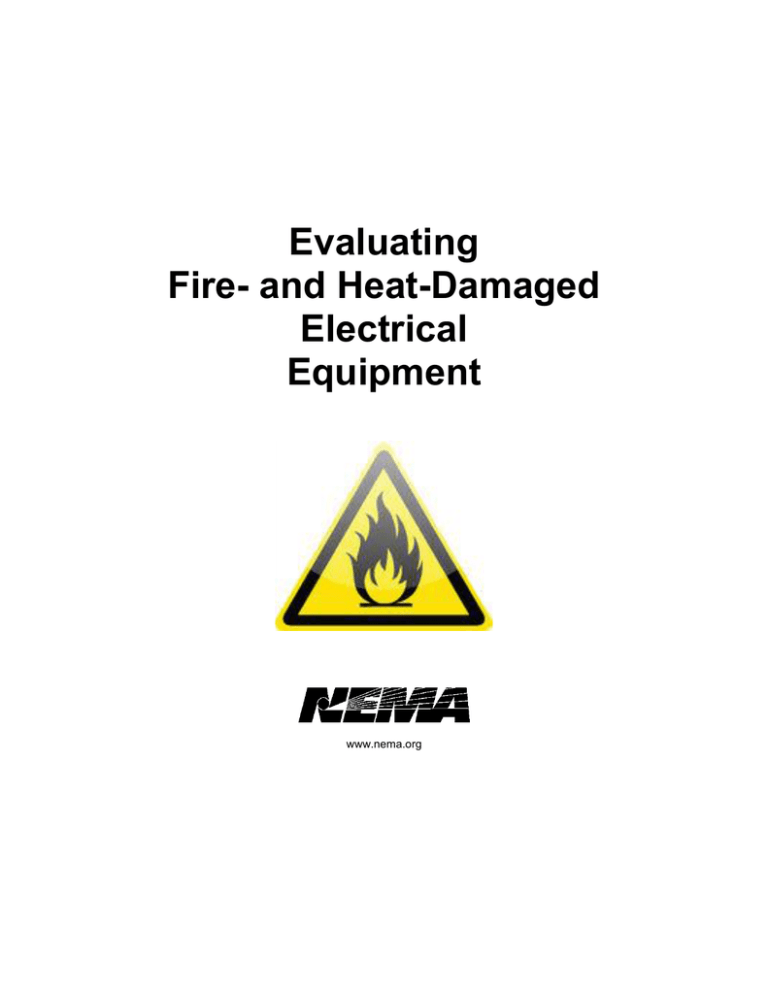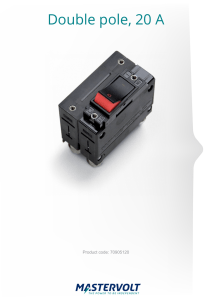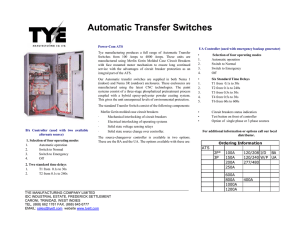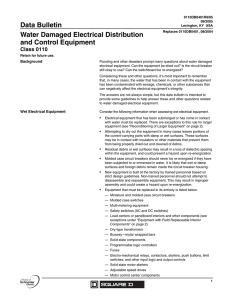Evaluating Fire- and Heat-Damaged Electrical Equipment
advertisement

Evaluating Fire- and Heat-Damaged Electrical Equipment www.nema.org 1 USE OF THIS PUBLICATION This publication provides information on how to evaluate electrical equipment that has been exposed to heat and fire residue through fire, firefighting activities, or close proximity to a fire. It is designed for use by suppliers, installers, inspectors, and users of electrical products. Electrical equipment exposed to heat and fire residue can be extremely hazardous if re-energized without first performing a proper evaluation and taking necessary action. Reduction in integrity of electrical equipment due to heat degradation of materials, residue from burning materials, or moisture can affect the ability of the equipment to perform its intended function and be used safely. Damage to electrical equipment can also result from airborne contaminates containing chemicals and other debris, which can affect the integrity and performance of the equipment. Smoke/soot from burning materials can be particularly damaging because of the corrosive and conductive nature of the residue. Damage caused by fire-suppression activities, structural damage, and weather exposure must also be considered. Distributors of electrical equipment should not supply any inventory that has been fire- or heat-damaged. Doing so can lead to use of damaged equipment that may not function correctly, creating a hazard to individuals or property. 2 CONTACT THE MANUFACTURER Working knowledge of electrical systems and of the equipment in question is required to evaluate damage related to a fire event. The original manufacturer of the equipment should be contacted if any questions arise or specific recommendations are needed. In many cases, equipment replacement will be necessary. After consultation with the manufacturer, some larger types of electrical equipment may be reconditioned by properly trained personnel. The potential for reconditioning can vary with the nature of the electrical function, the significance of the heat and fire residue, the age of the equipment, and the length of time the equipment was exposed to excessive heat or other damaging conditions. Because other damage to affected equipment can occur (e.g., chemical or structural damage), the equipment subject to the stresses of exposure to fire and/or heat needs to be carefully examined and evaluated to ensure that safety and performance are not negatively impacted. Attempts to recondition equipment without consulting the manufacturer can result in additional hazards due to the use of improper cleaning agents, which can further damage the equipment (see National Electrical Code® [NEC] Section 110.11, Informational Note No. 2) or due to improper reconditioning techniques. 3 ELECTRICAL EQUIPMENT REPLACEMENT/RECONDITIONING REQUIREMENTS The table below shows the requirements and recommendations associated with replacing/reconditioning various categories of electrical equipment that have been subjected to damage as a result of a fire event. Where it is shown that the equipment has “potential for reconditioning,” it is critical that the equipment manufacturer be contacted for specific guidance. © 2013 National Electrical Manufacturers Association Replace Equipment Equipment Potential for Reconditioning (contact the manufacturer) Additional Standards Reference (if available) ELECTRICAL DISTRIBUTION EQUIPMENT (refer to 4.1) Molded-case circuit breakers X Low-voltage fuses X Enclosed switches X Busway (Mylar-wrapped bars) X Busway (powder-coated bars) X Panelboards X Transfer switches X Switchboards ANSI/NEMA AB 4-2009, Guidelines for Inspection and Preventive Maintenance of Molded-Case Circuit Breakers Used in Commercial and Industrial Applications X NEMA KS 1-2001, Enclosed and Miscellaneous Distribution Equipment Switches (600 V Maximum), sections 5.1, 5.1.2 NEMA BU 1.1-2005, General Instructions for Handling, Installation, Operation, and Maintenance of Busway Rated 600 V or Less NEMA PB 1.1-2002, General Instructions for Proper Installation, Operation, and Maintenance of Panelboards Rated 600 V or Less, sections 10.3, 10.8.3, 10.8.4 NEMA ICS 10-2005, Industrial Controls and Systems, Part 1: Electromechanical AC Transfer Switch Equipment NEMA PB 2.1-2002, General Instructions for Proper Handling, Installation, Operation and Maintenance of Deadfront Distribution Switchboards Rated 600 V or Less, sections 11.3.1.3, 11.10 MOTOR CONTROL EQUIPMENT (refer to 4.2) Adjustable speed drives Components containing semiconductors and transistors Electronically controlled and solid-state contactors and starters Overload relays Manual and magnetic controllers Motor control centers X X X X X X © 2013 National Electrical Manufacturers Association Replace Equipment Equipment Potential for Reconditioning (contact the manufacturer) Additional Standards Reference (if available) POWER EQUIPMENT (refer to 4.3) Electronic trip units of LV power circuit breakers High-voltage power circuit breakers (AC) Medium-voltage power circuit breakers Low-voltage power circuit breakers Protective relays and meters (electromechanical) Protective relays and meters (electronic/digital) Low-voltage switchgear Medium-voltage switchgear Medium-voltage fuses X X X X X X X X X TRANSFORMERS (refer to 4.4) All dry-type transformers, regardless of kVA ratings All dry-type control circuit transformers X X X Liquid-filled transformers Cast-resin transformers (Analysis of the insulating medium is required for evaluation of this equipment) X CONDUIT, TUBING, FITTINGS, OUTLET BOXES, AND JUNCTION BOXES (refer to 4.5) Fittings Outlet and junction boxes Conduit and tubing NEMA FB 1-2007(R2010), Fittings, Cast Metal Boxes, and Conduit Bodies for Conduit, Electrical Metallic Tubing (EMT), and Cable X NEMA OS 1-2008 (R2010), Sheet-Steel Outlet Boxes, Device Boxes, Covers, and Box Supports NEMA OS 2-2008, Nonmetallic Outlet Boxes, Device Boxes, Covers, and Box Supports X X © 2013 National Electrical Manufacturers Association Replace Equipment Equipment Potential for Reconditioning (contact the manufacturer) Additional Standards Reference (if available) WIRE, CABLE, AND FLEXIBLE CORDS (refer to 4.6) Wire, cable, and flexible cords X AFCIs, GFCIs, SURGE-PROTECTIVE DEVICES, AND WIRING DEVICES (refer to 4.7) Arc Fault Circuit Interrupters (AFCIs) and Ground Fault Circuit Interrupters (GFCIs) Surge-protective devices (transient voltage surge suppressors, surge arresters, lightning arresters) Wiring devices (switches, receptacles, dimmers, etc.) ANSI/NEMA AB 4-2009, Guidelines for Inspection and Preventive Maintenance of Molded-Case Circuit Breakers Used in Commercial and Industrial Applications X X X OTHER DEVICES X Cable tray (refer to 4.8) (Replace damaged labels) Fire pump controllers X Luminaires (lighting fixtures) (refer to 4.9) X Motors (refer to 4.10) Fire-detection, signaling, protection, and communications systems (refer to 4.11) 4 4.1 NEMA ICS 15-1999 (R2004), Instructions for the Handling, Installation, Operation, and Maintenance of Electric Fire Pump Controllers Rated Not More Than 600V X ANSI/IEEE 43-2000, A2 and A3 X THE HAZARDS ASSOCIATED WITH FIRE- OR HEAT-DAMAGED ELECTRICAL EQUIPMENT Electrical Distribution Equipment Electrical distribution equipment usually involves switches and low-voltage protective components, such as molded-case circuit breakers and fuses within assemblies (enclosures, panelboards, and switchboards, for example). These assemblies can be connected to electrical distribution systems using various wiring methods. © 2013 National Electrical Manufacturers Association The protective components are critical to the safe operation of distribution circuits. Their ability to protect these circuits is adversely affected by exposure to fire or heat and the potential reduction in integrity of electrical equipment due to heat degradation of materials, residue from burning materials, or moisture. In molded-case circuit breakers and switches, such exposure can affect overall operation of the mechanism through contaminants, through the presence of foreign particles, and through loss of lubrication. The condition of the contacts can be affected, and the dielectric insulation capabilities of internal materials can be reduced. Further, some molded-case circuit breakers are equipped with electronic trip units, whose functioning can be impaired. Fire or heat can affect the filler material of fuses, degrading the insulation and interruption capabilities. Distribution assemblies contain protective components together with necessary support structures, buswork, wiring, and electromechanical or electronic relays and meters. Exposure to fire or heat can cause insulation damage and might lead to corrosion in all of these areas. In the case of exposure of distribution assemblies to fire or heat, contact the manufacturer before any action is taken. 4.2 Motor Control Equipment Motor circuits include motor control devices (motor starters and contactors, for example) along with overcurrent-protection components, such as overload relays, circuit breakers, and fuses that are often assembled into motor control panels and motor control centers or individual enclosures. Motor control centers contain both control and protective components, as well as support structures, buswork, and wiring. The protective components are critical to the safe operation of motor circuits. Their ability to protect these circuits is adversely affected by exposure to fire or heat and the potential reduction in integrity of electrical equipment due to heat degradation of materials, residue from burning materials, or moisture. For molded-case circuit breakers, such exposure can affect the overall operation of the mechanism through contaminates, through the presence of foreign particles, and through loss of lubrication. The condition of the contacts can be affected, and the dielectric insulation capabilities of internal materials can be reduced. Further, some molded-case circuit breakers are equipped with electronic trip units, and the functioning of these trip units can be impaired. Fire or heat can affect the filler material of fuses and will degrade the insulation and interruption capabilities. Corrosion, loss of lubrication, and insulation quality can also be expected in contactors and starters. Solid-state motor controllers, adjustable speed drives, and those electromechanical contactors or starters with integral electronic circuitry will be more severely affected by fire or heat. 4.2.1 Adjustable Speed Drives Adjustable speed drives contain electronic components and might contain transformers or other electrical devices that could be affected by exposure to fire or heat. See 4.11 for information on equipment with electronic components. For other components of an adjustable speed drive, the ability to refurbish those components will depend on the type of component involved and the extent of the damage. The manufacturer of the drive must be consulted prior to any attempt to refurbish the equipment. 4.2.2 Motor Control Centers Motor control centers contain many different components, including fuses, circuit breakers, controllers, overload relays, adjustable speed drives and components such as buswork, insulators, and enclosures. Many of these components are covered in other parts of this document, which should be referenced for additional information on those components. For the buswork and structural assembly, exposure to fire or heat can cause insulation damage and lead to corrosion. For these assemblies, contact the manufacturer before action is taken. © 2013 National Electrical Manufacturers Association 4.3 Power Equipment Power equipment involves low- or medium-voltage protective devices within an overall switchgear assembly. The assembly may also contain cabling, buswork with appropriate insulators, current transformers (refer to 4.4), electromechanical or electronic relays, and metering. Reliable operation of the protective devices is vital to system safety. These devices can be adversely affected by fire or heat. In the case of low-voltage power circuit breakers and medium-voltage power circuit breakers and switches, the operation of the mechanism can be impaired by the presence of carbon particles, or debris removal of lubricants and potential corrosion. The dielectric properties of insulation materials and insulators will degrade and, for air circuit breakers, the condition of the contacts can be affected. Further, low-voltage power circuit breakers usually incorporate electronic trip units; the functioning of these units will be impaired. Similarly, the functionality of electromechanical or electronic protective relays and meters can be impaired. See 4.11 for additional information on electronic components. Fire or heat can affect the filler material of fuses and will degrade the insulation and interruption capabilities. Low- and medium-voltage power circuit breakers may be designed to be maintained by replacing contacts in air circuit breakers. Therefore, it might be possible to reuse such circuit breakers provided the refurbishing is performed in close consultation with the manufacturer. This includes cleaning and restoration techniques, lubrication advice, and thorough testing prior to the reapplication of power. Discard and replace the electronic trip units of low-voltage power circuit breakers and electronic protective relays and meters in any power equipment. Replace fusible units of fused equipment. The remainder of the apparatus might be suitable for refurbishing in close consultation with the manufacturer. Medium-voltage power circuit breakers using vacuum interrupters can become contaminated with foreign material that becomes lodged in the bellows of the device, impeding contact movement and vacuum integrity. The manufacturer must be consulted. In all cases, great attention must be paid to the thorough cleaning, restoration, and testing of insulators, insulation material, and mechanisms. The power equipment can be expected to contain additional electronic units, such as solid-state relays. These units can also be vital to the correct functioning of the protective device, and great care is needed in the cleaning and testing of such units. A first recommendation is to return the devices to the manufacturer. If this is not possible, the manufacturer should be consulted on the correct selection of cleaning agents that remove impurities without damaging the conformal coating. The manufacturer shall also be contacted for the specific testing required of sophisticated electronic equipment containing, for example, microprocessors. It is possible that the overall power equipment assembly (switchgear) can be reconditioned, depending on the degree of heat, and provided careful steps are taken in the cleaning, restoration, and testing of the equipment prior to applying power. This requires input and advice from the manufacturer. An area of particular concern is the maintenance of the dielectric properties of insulation. In the field application of medium-voltage equipment, standoff insulators are subjected to a variety of high-voltage surges. Such insulators might need replacement. 4.4 Transformers Exposure of transformers to fire or heat can cause insulation damage and lead to corrosion of the transformer core and winding. The ability of the transformer to perform its intended function in a safe manner can also be impaired by debris and chemicals, which may be deposited inside the transformer during a fire. © 2013 National Electrical Manufacturers Association Liquid-filled transformers might sustain advanced thermal aging of the sealing gaskets, the transformer insulation, the dielectric fluid, and the tank paint due to the higher-than-normal ambient temperatures from the fire, such that transformer replacement may be justified even without significant visual damage to the equipment. This risk of transformer damage should be considered if the recommendation to replace the equipment is not followed. 4.5 Conduit, Tubing, Fittings, Outlet Boxes, and Junction Boxes 4.5.1 Outlet Boxes and Fittings Outlet boxes and fittings, whether metallic or nonmetallic, have not been evaluated for effects of exposure to conditions described in “Use of this Publication.” The presence of known or unknown corrosive agents in a fire event in particular can affect the physical properties of metallic and nonmetallic materials and the required corrosion protection for electrical equipment according to NEC Section 300.6. Therefore, replacement of outlet boxes and fittings in accordance with original installation requirements is recommended. 4.5.2 Conduit and Tubing In the case of fire or extreme heat exposure, or fire-fighting activities, conduit and tubing must be carefully inspected to determine if the mechanical and electrical integrity of the conduit/tubing system has been compromised. As part of the inspection process, assure that the interior of the conduit/tubing is clear. In addition, contaminants or heat can also affect the physical properties of metallic and nonmetallic materials and the corrosion protection for electrical equipment as required in NEC Section 300.6. Since every situation has unique circumstances, the services of an experienced evaluator should be used. The manufacturer can also be consulted for additional assistance. 4.6 Wire, Cable, and Flexible Cords When any wire or cable product is exposed to fire or extreme heat, all components are subject to damage. The conductor metal and/or insulation may be damaged, causing failure or premature failure. Wire and cable may also be damaged due to the water exposure from firefighting. Termination failures due to heating effects, mechanical stress, or fault conditions are also possible. 4.7 AFCIs, GFCIs, Surge-Protective Devices, and Wiring Devices Fire and heat, or residual contaminates from fire, can adversely affect the performance of these products without being readily apparent to the user community. Also, electrical products, such as AFCIs, GFCIs and surge-protective devices, contain electronic circuitry and other components that can be adversely affected by extreme heat, resulting in the device becoming nonfunctional and/or a potential hazard to the user. Washing, rinsing, or repairing fire-damaged products of this type should not be attempted. 4.8 Cable Tray Carefully inspect the cable tray system to determine if its mechanical and/or electrical integrity has been compromised. Repair or replace any damaged portions per original installation requirements. Remove all debris from the cable tray. If any labels warning against the use of the cable tray as a walkway have been damaged, obtain new labels from the manufacturer and apply as required. © 2013 National Electrical Manufacturers Association 4.9 Luminaires (Lighting Fixtures), Ballasts, and LED Drivers Fluorescent, high-intensity discharge, incandescent and LED luminaires can be affected due to fire, extreme heat, or residue from a fire. Luminaires and associated equipment exposed to fire or heat can be damaged by corrosive materials, sediment, or other debris. Corrosion of metallic parts and contamination of internal circuitry might prevent the equipment from operating properly. 4.10 Motors Motors that have been exposed to fire or extreme heat may be subjected to damage. This may result in damage to insulation, switches, contacts of switches, capacitors and overload protectors, corrosion of metallic parts, and contamination of the lubricating means and should be evaluated by qualified personnel. 4.11 Electronic Products, Including Fire Detection, Signaling, Protection, Communication Systems, and Industrial Controls Equipment used in signaling, protection, and communication systems generally contains electronic components, and the exposure of such equipment to fire or extreme heat can adversely affect the reliability of those systems. Contamination by pollutants or debris from a fire can cause corrosion of system components, shorting or alteration of printed circuits, or alteration of circuit characteristics. Since some of these types of installations are classified as life safety systems, it is important that the reliability of these systems be maintained. Where such systems are damaged by fire or extreme heat, they should be replaced. 4.12 Exposure to Water In many cases, electrical equipment that has been exposed to heat, fire, and/or smoke is also likely to have been exposed to the water used to extinguish the fire. This equipment should be evaluated for damage resulting from water exposure or replaced (see NEMA guide Evaluating Water-Damaged Electrical Equipment). DISCLAIMER: The standards or guidelines presented in a NEMA standards publication are considered technically sound at the time they are approved for publication. They are not a substitute for a product seller’s or user’s own judgment with respect to the particular product referenced in the standard or guideline, and NEMA does not undertake to guarantee the performance of any individual manufacturer’s products by virtue of this standard or guide. Thus, NEMA expressly disclaims any responsibility for damages arising from the use, application, or reliance by others on the information contained in these standards or guidelines. © 2013 National Electrical Manufacturers Association National Electrical Manufacturers Association th 1300 North 17 Street, Suite 900 Rosslyn, Virginia 22209 Telephone: (703) 841-3236 Fax: (703) 841-3336 ATTN: Vince Baclawski email: vin_baclawski@nema.org www.nema.org © 2013 National Electrical Manufacturers Association


